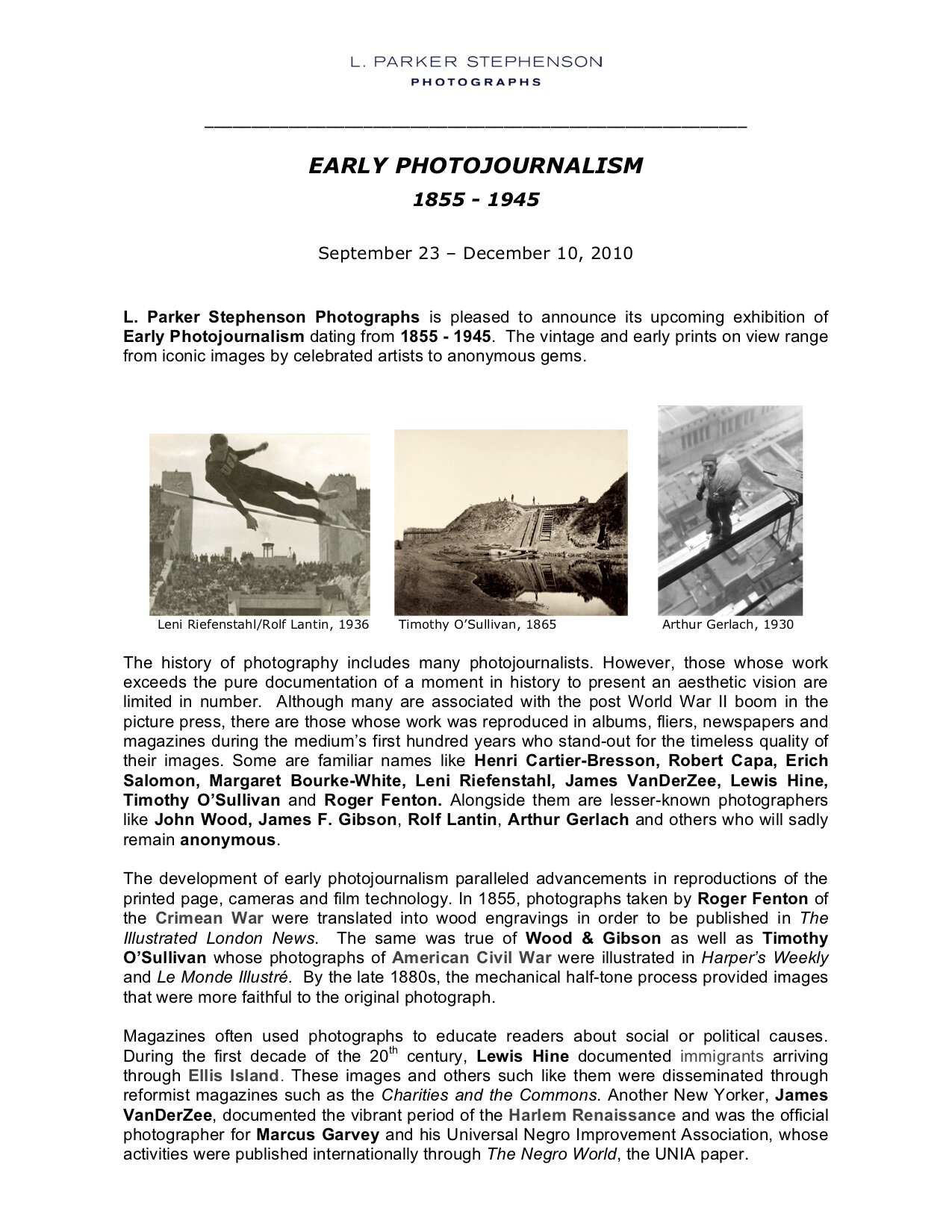EARLY PHOTOJOURNALISM | PRESS RELEASE
L. Parker Stephenson Photographs is pleased to announce its upcoming exhibition of Early Photojournalism dating from 1855 -1945. The vintage and early prints on view range from iconic images by celebrated artists to anonymous gems
The history of photography includes many photojournalists. However, those whose work exceeds the pure documentation of a moment in history to present an aesthetic vision are limited in number. Although many are associated with the post World War II boom in the picture press, there are those whose work was reproduced in albums, fliers, newspapers and magazines during the medium’s first hundred years who stand-out for the timeless quality of their images. Some are familiar names like Henri Cartier-Bresson, Robert Capa, Erich Salomon, Margaret Bourke-White, Leni Riefenstahl, James VanDerZee, Lewis Hine, Timothy O’Sullivan and Roger Fenton. Alongside them are lesser-known photographers like John Wood, James F. Gibson, Rolf Lantin, Arthur Gerlach and others who will sadly remain anonymous.
The development of early photojournalism paralleled advancements in reproductions of the printed page, cameras and film technology. In 1855, photographs taken by Roger Fenton of the Crimean War were translated into wood engravings in order to be published in The Illustrated London News. The same was true of Wood & Gibson as well as Timothy O’Sullivan whose photographs of American Civil War were illustrated in Harper’s Weekly and Le Monde Illustré. By the late 1880s, the mechanical half-tone process provided images that were more faithful to the original photograph.
Magazines often used photographs to educate readers about social or political causes. During the first decade of the 20th century, Lewis Hine documented immigrants arriving through Ellis Island. These images and others such like them were disseminated through reformist magazines such as the Charities and the Commons. Another New Yorker, James VanDerZee, documented the vibrant period of the Harlem Renaissance and was the official photographer for Marcus Garvey and his Universal Negro Improvement Association, whose activities were published internationally through The Negro World, the UNIA paper.
With the rise of magazines in Europe and the US in the 1930s, many photographers were employed to illustrate articles. During this period Margaret Bourke-White was among the most sought after. Her photographs of industry printed in Fortune reflected a modernist aesthetic and the aggrandizement of progress as revealed in an abstract image of tractor’s disc harrow in 1930 Russia. A less recognized name, Arthur Gerlach, also worked for Fortune and provided startling graphic images of construction workers balanced on girders of buildings towering above the street.
Along with the inventions of the dry plate process and, later roll film, the new breed of small, lightweight cameras with faster shutter speeds facilitated taking un-posed images. Erich Salomon, generally considered the first modern photojournalist, shocked readers of Berliner Illustriete Zeitung and Fortune by photographing world leaders and influential figures such as Albert Einstein during unguarded moments. Henri Cartier-Bresson, was another master of spontaneity and his picture of children playing joyously among the ruins in Seville, is a classic example of this style. Leni Riefenstahl has long been credited with triumphant images of the 1936 Berlin Olympics. However, it may have been her assistant, still-photographer Rolf Lantin, who captured a US high jumper who, in mid-leap, frames the Olympic torch in the background.
Marking the end of WWII, Robert Capa photographed a French collaborator who was paraded through town, with a shorn head and a child in her arms, to the jeers of the crowds. After the war, a new era in photojournalism was ushered in with the launch of photo agencies such as Magnum in 1946 and the explosion of the picture press.
For more information on these artists or for additional visuals, please contact the gallery at 212.517.8700 or visit us online at www.lparkerstephenson.nyc. L. Parker Stephenson Photographs will be open Wednesday through Saturday from 11am-6pm until November 6th after which time we will open by appointment for the remainder of the show.


